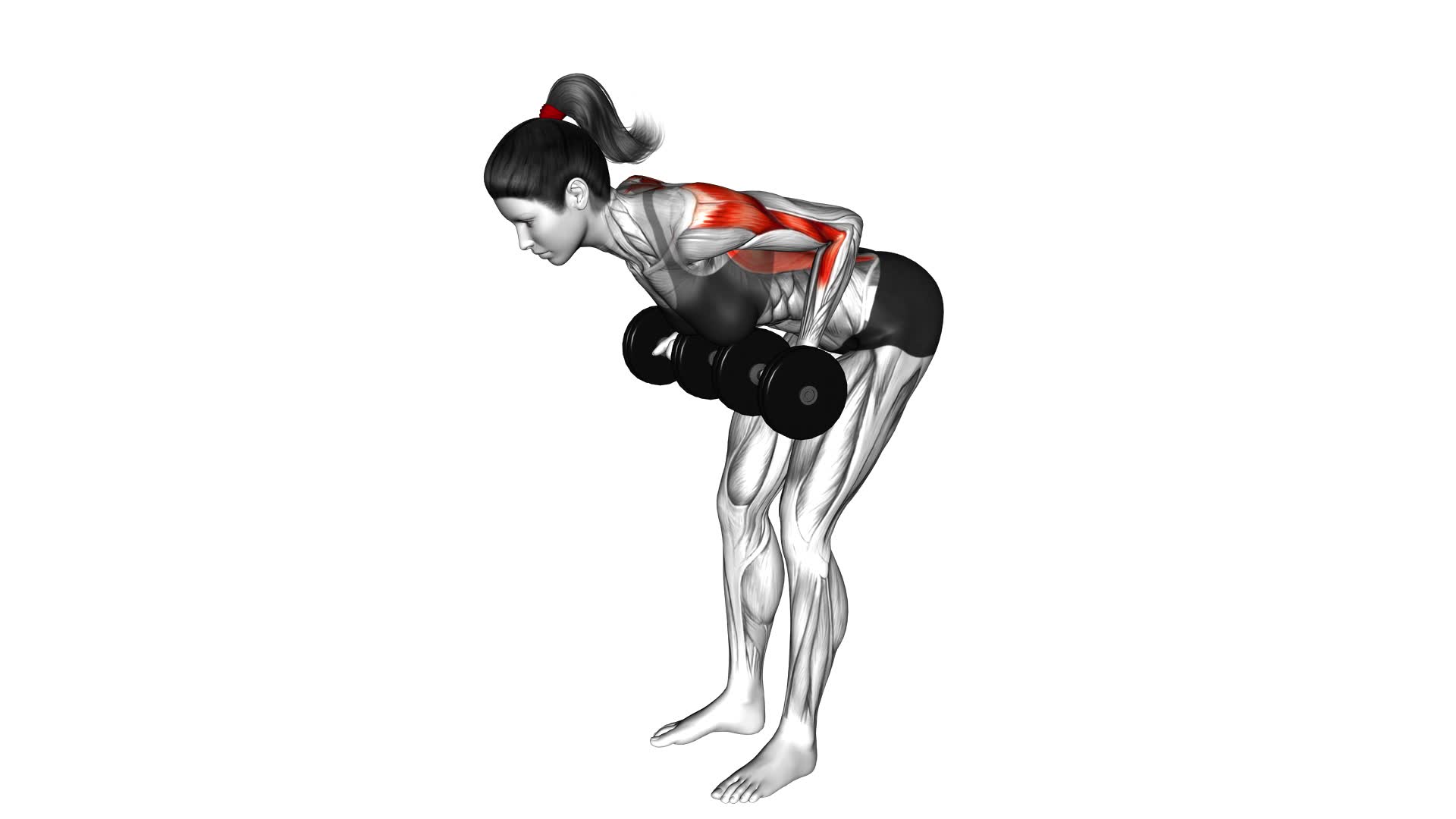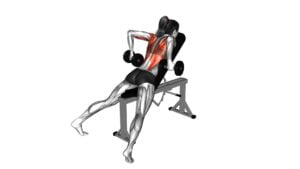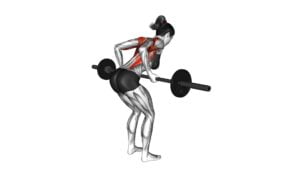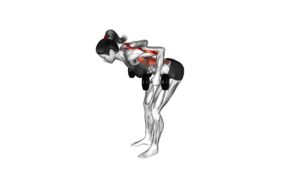Dumbbell Reverse Grip Row (female) – Video Exercise Guide & Tips

Are you looking for a challenging and effective exercise to target your back muscles? Look no further than the dumbbell reverse grip row!
Watch This Exercise Video
This exercise, specifically designed for females, is a great way to strengthen and tone your back. In this video exercise guide, you'll learn the proper form and technique, as well as tips to avoid common mistakes.
Get ready to level up your workout and achieve your fitness goals with the dumbbell reverse grip row.
Key Takeaways
- Dumbbell Reverse Grip Row improves posture and increases upper body strength
- Proper form and technique are important to engage the targeted muscles and avoid injuries
- Choose the right dumbbell weight for your fitness level and gradually increase as you become stronger
- Avoid common mistakes such as using too much weight, rounding the back, and relying on momentum. Focus on proper technique and challenge yourself with variations and progressions.
Benefits of the Dumbbell Reverse Grip Row
Discover the numerous benefits of performing the Dumbbell Reverse Grip Row exercise. This exercise is highly effective in improving your posture and increasing your upper body strength. By incorporating the Dumbbell Reverse Grip Row into your workout routine, you can achieve these benefits in a concise and efficient manner.
One of the key benefits of this exercise is improved posture. By targeting the muscles in your upper back, shoulders, and arms, the Dumbbell Reverse Grip Row helps to strengthen these muscles, which in turn helps to improve your posture. As you perform this exercise, you engage your back muscles, pulling the dumbbells towards your body while keeping your shoulders back and down. This action helps to counteract the effects of poor posture and promotes a more upright and aligned position.
Additionally, the Dumbbell Reverse Grip Row is an excellent exercise for increasing upper body strength. As you row the dumbbells towards your body, you engage and challenge the muscles in your back, shoulders, and arms. This exercise targets the rhomboids, trapezius, biceps, and forearms, among other muscles. With consistent practice, you can expect to see a significant improvement in your upper body strength.
Incorporating the Dumbbell Reverse Grip Row into your workout routine can provide you with the benefits of improved posture and increased upper body strength. Make sure to maintain proper form and gradually increase the weight as you progress. Consult with a fitness professional to ensure that you're performing this exercise correctly and safely.
Proper Form and Technique
To perform the Dumbbell Reverse Grip Row exercise with proper form and technique, grip the dumbbells with an underhand grip and pull them towards your body, engaging your back muscles and keeping your shoulders back and down. This exercise primarily targets your back muscles, including the latissimus dorsi and rhomboids. It also engages your biceps and forearms to a lesser extent.
When performing the Dumbbell Reverse Grip Row, it's important to maintain a neutral spine and avoid rounding your back. Common errors to watch out for include using too much momentum to lift the dumbbells, which reduces muscle engagement and effectiveness of the exercise. Additionally, avoid pulling the dumbbells too close to your chest, as this can strain your shoulders.
To maximize muscle engagement, focus on squeezing your shoulder blades together at the top of the movement and maintaining control throughout the entire exercise. Remember to exhale as you pull the dumbbells towards your body and inhale as you return to the starting position.
Now that you understand the proper form and technique of the Dumbbell Reverse Grip Row, the next step is to choose the right dumbbell weight to challenge your muscles without compromising your form.
Choosing the Right Dumbbell Weight
Now that you understand the proper form and technique of the Dumbbell Reverse Grip Row, how do you determine the appropriate weight to challenge your muscles effectively? It's important to choose the right dumbbell weight to avoid injury risks and ensure that you're challenging your muscles enough to see progress.
To determine the appropriate weight for the Dumbbell Reverse Grip Row, you need to assess your current strength level. Start with a weight that you can comfortably lift for 10 to 12 repetitions with proper form. If you can easily complete more than 12 repetitions, the weight is too light and you should increase it. On the other hand, if you struggle to complete 8 repetitions, the weight is too heavy and you should decrease it.
Remember, it's better to start with a lighter weight and gradually increase it as you become stronger. This will help you avoid overexertion and reduce the risk of injury. It's important to listen to your body and not push yourself too hard too soon.
Common Mistakes to Avoid
Are you making any common mistakes while performing the Dumbbell Reverse Grip Row that could hinder your progress and increase the risk of injury? It's important to ensure you're using proper technique to maximize the effectiveness of this exercise and avoid any potential mishaps.
Here are three common mistakes to avoid:
- Using too much weight: One of the most common mistakes is using a weight that's too heavy for you. This can compromise your form and put unnecessary strain on your muscles and joints. Start with a weight that challenges you but still allows you to maintain proper form throughout the exercise.
- Rounded back: Another common mistake is rounding your back during the movement. This not only reduces the effectiveness of the exercise but also increases the risk of lower back injuries. Keep your back straight and maintain a neutral spine position throughout the entire movement.
- Jerking the weights: Many people tend to use momentum to lift the weights instead of relying on their back muscles. This not only takes the focus away from the targeted muscles but also increases the risk of injury. Control the movement and avoid any jerking or swinging motions.
Variations and Progressions
Once you have mastered the proper technique of the Dumbbell Reverse Grip Row, you can explore various variations and progressions to further challenge your muscles and continue making progress in your fitness journey.
To add an extra level of difficulty and intensity to your workout, you can try advanced modifications of the exercise. One option is to increase the weight of the dumbbells you're using. This will require your muscles to work harder to lift and control the heavier load, leading to increased strength and muscle growth.
Another variation is to perform the exercise on an unstable surface, such as a stability ball or a BOSU ball. This will engage your core muscles even more, as they work to stabilize your body during the movement.
In addition to advanced modifications, you can also incorporate muscle targeting techniques to focus on specific muscle groups. For example, you can perform a single-arm dumbbell reverse grip row to isolate and strengthen one side of your back at a time. Another option is to vary the grip width by using a wider or narrower grip. This will shift the emphasis to different muscles in your back, providing a well-rounded workout.
Remember to always maintain proper form and technique when attempting variations and progressions. Start with a weight and difficulty level that challenges you but still allows you to perform the exercise with good form. As you become more comfortable and stronger, gradually increase the intensity and difficulty of the variations. By continuously challenging your muscles and incorporating different techniques, you'll continue to see progress and reach your fitness goals.
Tips for a Successful Workout
To have a successful workout, prioritize proper form and technique. By following these tips, you can prevent injuries and maximize your results:
- Warm up properly: Before starting any exercise, it's crucial to warm up your muscles and increase blood flow. This will help prevent injuries and prepare your body for the workout ahead.
- Listen to your body: Pay attention to any discomfort or pain during your workout. Pushing through pain can lead to injuries. If something doesn't feel right, modify the exercise or seek guidance from a fitness professional.
- Gradually increase intensity: It's important to progress gradually and avoid overexertion. Pushing yourself too hard too soon can lead to burnout or injuries. Increase the weight or intensity of your workout gradually to challenge yourself without risking injury.
Frequently Asked Questions
Can I Do the Dumbbell Reverse Grip Row if I Have a Shoulder Injury?
If you have a shoulder injury, it's important to consult with your healthcare professional before attempting the dumbbell reverse grip row. They can provide guidance on modifications or alternatives that are safe for your condition.
It's crucial to prioritize your shoulder's healing and avoid any exercises that may aggravate the injury.
How Many Sets and Reps Should I Do for the Dumbbell Reverse Grip Row?
To determine the number of sets and reps for the dumbbell reverse grip row, consider your fitness level and goals. Start with 3 sets of 10-12 reps, and gradually increase the weight and intensity as you progress.
Remember to maintain proper form and engage your back muscles throughout the exercise.
Dumbbell reverse grip row variations can target different areas of your back and enhance muscle growth.
The benefits of dumbbell reverse grip row include improved posture, increased upper body strength, and enhanced back definition.
Is It Necessary to Warm up Before Performing the Dumbbell Reverse Grip Row?
Before performing any strength training exercise, it's important to warm up your muscles. Warming up helps increase blood flow and flexibility, reducing the risk of injury. It also prepares your body for the upcoming workout.
There are various warm up exercises you can do to prepare for the dumbbell reverse grip row, such as shoulder rotations and lat stretches. Incorporating these warm up exercises into your routine will help optimize your performance and prevent muscle strains.
Can I Substitute the Dumbbell Reverse Grip Row With a Machine Exercise?
Yes, you can substitute the dumbbell reverse grip row with a machine exercise.
Machine exercises can be a great alternative if you don't have access to dumbbells or prefer using machines. They provide stability and help target the same muscles as the dumbbell reverse grip row.
Some machine exercises that you can try include the seated cable row or the machine row.
Remember to adjust the weight and maintain proper form to maximize the benefits of the exercise.
Are There Any Modifications for Pregnant Women to Safely Perform the Dumbbell Reverse Grip Row?
To modify the dumbbell reverse grip row for pregnant women and ensure safety, there are a few important considerations.
First, consult with your healthcare provider before starting any new exercise routine.
Second, reduce the weight and focus on maintaining proper form to avoid straining your back or abdomen.
Third, listen to your body and stop if you feel any discomfort or pain.
Lastly, consider alternative exercises that are more suitable for pregnancy, such as seated cable rows or resistance band rows.
Conclusion
In conclusion, the dumbbell reverse grip row is a highly effective exercise for females that targets the back muscles. By maintaining proper form and technique, choosing the right dumbbell weight, and avoiding common mistakes, you can maximize the benefits of this exercise.
Additionally, incorporating variations and progressions into your routine can help you continually challenge and improve your strength. Remember to follow these tips for a successful workout and enjoy the benefits of a stronger and toned back.

Author
Years ago, the spark of my life’s passion ignited in my mind the moment I stepped into the local gym for the first time. The inaugural bead of perspiration, the initial endeavor, the very first surge of endorphins, and a sense of pride that washed over me post-workout marked the beginning of my deep-seated interest in strength sports, fitness, and sports nutrition. This very curiosity blossomed rapidly into a profound fascination, propelling me to earn a Master’s degree in Physical Education from the Academy of Physical Education in Krakow, followed by a Sports Manager diploma from the Jagiellonian University. My journey of growth led me to gain more specialized qualifications, such as being a certified personal trainer with a focus on sports dietetics, a lifeguard, and an instructor for wellness and corrective gymnastics. Theoretical knowledge paired seamlessly with practical experience, reinforcing my belief that the transformation of individuals under my guidance was also a reflection of my personal growth. This belief holds true even today. Each day, I strive to push the boundaries and explore new realms. These realms gently elevate me to greater heights. The unique combination of passion for my field and the continuous quest for growth fuels my drive to break new ground.



